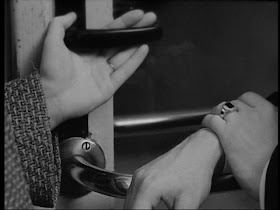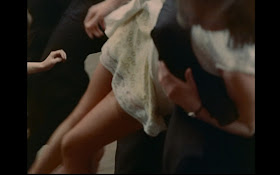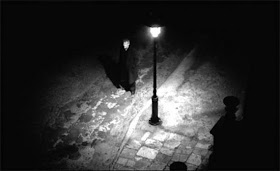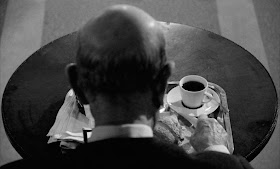Andrzej Wajda, a Polish director with style and an apparent love for hats, channels Beatnik vibes by combining a captain's cap with an aviator jacket and later migrating to a cossack hat. Sure these garments were popular in the 1960s, particularly in the colder parts of Eastern Europe, but I like to imagine that he graced his sets à la Hitchcock when he wore his suits.

Eastern European cinema is a diverse subject that has been scarcely regarded, especially compared to other world cinemas. From screen analysis to personal accounts, this blog is a meditation on Eastern European cultural values with emphasis on totalitarian iconography and other clandestine ciphers that have become motifs across the films of Romania, Hungary, Bulgaria, Poland, Russia, Czech Republic and East Germany.
Friday, April 26, 2013
Fashion in Film: Andrzej Wajda
By Olivia Maria Hărşan
Andrzej Wajda, a Polish director with style and an apparent love for hats, channels Beatnik vibes by combining a captain's cap with an aviator jacket and later migrating to a cossack hat. Sure these garments were popular in the 1960s, particularly in the colder parts of Eastern Europe, but I like to imagine that he graced his sets à la Hitchcock when he wore his suits.
Andrzej Wajda, a Polish director with style and an apparent love for hats, channels Beatnik vibes by combining a captain's cap with an aviator jacket and later migrating to a cossack hat. Sure these garments were popular in the 1960s, particularly in the colder parts of Eastern Europe, but I like to imagine that he graced his sets à la Hitchcock when he wore his suits.
Thursday, April 25, 2013
Thursday, April 18, 2013
Women in Film: Elisabeta Bostan
By Olivia Maria Hărşan
Born in 1931, Romanian director and screenwriter Elisabeta Bostan has experienced a fruitful and lifelong career in filmmaking. Having developed a passion for playwriting and stage direction as a high schooler, Bostan furthered her interests by enrolling at the Institute of Theatre and Film in Bucharest where she graduated in Film Direction in 1954. Bostan commenced her ouvre with short films and documentaries before moving on to direct her first feature Kid/ Pustiul (1962). However, her most successful films to date are Veronica (1972) and it's sequel Veronica Returns/ Veronica se întoarce (1975) both of which she wrote in collaboration with writer and producer Vasilica Istrate. In 1966 Bostan went on to found the International Student Film Festival in Romania titled 'CineMAiubit'. She is now dean and professor at the same university where she mastered her craft and serves part of the board of directors at the National Centre of Cinematography (CNC).
Born in 1931, Romanian director and screenwriter Elisabeta Bostan has experienced a fruitful and lifelong career in filmmaking. Having developed a passion for playwriting and stage direction as a high schooler, Bostan furthered her interests by enrolling at the Institute of Theatre and Film in Bucharest where she graduated in Film Direction in 1954. Bostan commenced her ouvre with short films and documentaries before moving on to direct her first feature Kid/ Pustiul (1962). However, her most successful films to date are Veronica (1972) and it's sequel Veronica Returns/ Veronica se întoarce (1975) both of which she wrote in collaboration with writer and producer Vasilica Istrate. In 1966 Bostan went on to found the International Student Film Festival in Romania titled 'CineMAiubit'. She is now dean and professor at the same university where she mastered her craft and serves part of the board of directors at the National Centre of Cinematography (CNC).
Tuesday, April 16, 2013
Film Preview: An Episode in the Life of an Iron Picker/ Epizoda u životu berača željeza (2013) Danis Tanović
By Olivia Maria Hărşan
Bosnian filmmaker, Danis Tanović blurs the line between realism as a genre and documentary filmmaking resulting in a highly innovative approach well worthy of the attention it received at the Berlinale earlier this year.
Bosnian filmmaker, Danis Tanović blurs the line between realism as a genre and documentary filmmaking resulting in a highly innovative approach well worthy of the attention it received at the Berlinale earlier this year.
Monday, April 15, 2013
Visual Diary: Loves of a Blonde/ Lásky jedné plavovlásky (1965) Miloš Forman
By Olivia Maria Hărşan
Optic white, optic black. Forman's powerful imagery from a very early stage in his career.
Optic white, optic black. Forman's powerful imagery from a very early stage in his career.
Friday, April 12, 2013
Fashion in Film: Magdaléna Vášáryová
By Olivia Maria Hărşan
The stunning Czech actress Magdaléna Vášáryová captured in three mesmerizing black and white portraits. Circa 1960-70s.
The stunning Czech actress Magdaléna Vášáryová captured in three mesmerizing black and white portraits. Circa 1960-70s.
Thursday, April 11, 2013
Women in Film: Sonja Savić
By Olivia Maria Hărşan
Noted and perhaps fetishized for her husky voice and sleek brown hair, cult film actress Sonja Savić, became something of a rebel in Serbia (former Yugoslavia), voicing strong opinions against her nation's political changes. Born in Čačak, Yugoslavia in 1961, Savić impressed audiences with a series of strong performances throughout the 1980s before turning her focus to addressing cultural matters of her country. She died in 2008, reportedly from a drug overdose.
Noted and perhaps fetishized for her husky voice and sleek brown hair, cult film actress Sonja Savić, became something of a rebel in Serbia (former Yugoslavia), voicing strong opinions against her nation's political changes. Born in Čačak, Yugoslavia in 1961, Savić impressed audiences with a series of strong performances throughout the 1980s before turning her focus to addressing cultural matters of her country. She died in 2008, reportedly from a drug overdose.
Friday, April 5, 2013
Fashion in Film: The Firemen's Ball (1967) Miloš Forman
By Olivia Maria Hărşan
For those who have seen Miloš Forman's The Firemen's Ball/ Hoří, má panenko (1967) might think it to be a strange choice for the 'fashion in film' section of this blog, but I beg to differ. No matter how low budget the film, the amount of socio-political restrictions of its context or even the absence of a costume designer per se, there is always room for fashion analysis. In this case, the party scene stands out as a peculiar emphasis on costuming through its focus of female sexuality.
The narrative is centered around a catered party hosted by the local fire department. The aim of the event is to celebrate the birthday of the honorary chairman and to judge a poorly organised beauty queen contest. Throughout the evening a series of farcical events occur, which lead to complete havoc in the community hall. The chosen finalists, all teenage girls, refuse to go on stage, instead seeking refuge in the ladies bathroom. Men start chasing women around while older folk laugh at the scene from the sidelines.
The cinematography is unconventional and bold. For the majority of the film, the camera invades the personal space of the characters with close-ups comparable to John Cassavetes' Faces (1968). What is most impressive, though, are the swift visual angles throughout the chaotic party scene. A great deal of attention is paid to the female body particularly via the fetishized images of long necklaces leading to the breasts, evening styled coiffures, cat's eye make-up, sheer thigh high stockings and patent black heels.
The film was banned in Czechoslovakia for supposedly obtaining dissident values contrary to the Communist idealism of the time. In response, Forman states :
"I didn't want to give any special message or allegory. I wanted just to make a comedy knowing that if I'll be real, if I'll be true, the film will automatically reveal an allegorical sense. That's a problem of all governments, of all committees, including firemen's committees. That they try and they pretend and they announce that they are preparing a happy, gay, amusing evening or life for the people. And everybody has the best intentions... But suddenly things turn out in such a catastrophic way that, for me, this is a vision of what's going on today in the world." (Hames P 2005, The Czechoslovak New Wave, Wallflower Press, London and New York, pp. 120).
For those who have seen Miloš Forman's The Firemen's Ball/ Hoří, má panenko (1967) might think it to be a strange choice for the 'fashion in film' section of this blog, but I beg to differ. No matter how low budget the film, the amount of socio-political restrictions of its context or even the absence of a costume designer per se, there is always room for fashion analysis. In this case, the party scene stands out as a peculiar emphasis on costuming through its focus of female sexuality.
The narrative is centered around a catered party hosted by the local fire department. The aim of the event is to celebrate the birthday of the honorary chairman and to judge a poorly organised beauty queen contest. Throughout the evening a series of farcical events occur, which lead to complete havoc in the community hall. The chosen finalists, all teenage girls, refuse to go on stage, instead seeking refuge in the ladies bathroom. Men start chasing women around while older folk laugh at the scene from the sidelines.
The cinematography is unconventional and bold. For the majority of the film, the camera invades the personal space of the characters with close-ups comparable to John Cassavetes' Faces (1968). What is most impressive, though, are the swift visual angles throughout the chaotic party scene. A great deal of attention is paid to the female body particularly via the fetishized images of long necklaces leading to the breasts, evening styled coiffures, cat's eye make-up, sheer thigh high stockings and patent black heels.
The film was banned in Czechoslovakia for supposedly obtaining dissident values contrary to the Communist idealism of the time. In response, Forman states :
"I didn't want to give any special message or allegory. I wanted just to make a comedy knowing that if I'll be real, if I'll be true, the film will automatically reveal an allegorical sense. That's a problem of all governments, of all committees, including firemen's committees. That they try and they pretend and they announce that they are preparing a happy, gay, amusing evening or life for the people. And everybody has the best intentions... But suddenly things turn out in such a catastrophic way that, for me, this is a vision of what's going on today in the world." (Hames P 2005, The Czechoslovak New Wave, Wallflower Press, London and New York, pp. 120).
Wednesday, April 3, 2013
Women in Film: Marina Goldovskaya
By Olivia Maria Hărşan
A captivating image of the Russian director, screenwriter, cinematographer and producer Marina Goldovskaya on set - a woman with a camera in a Socialist context.
A captivating image of the Russian director, screenwriter, cinematographer and producer Marina Goldovskaya on set - a woman with a camera in a Socialist context.


























































